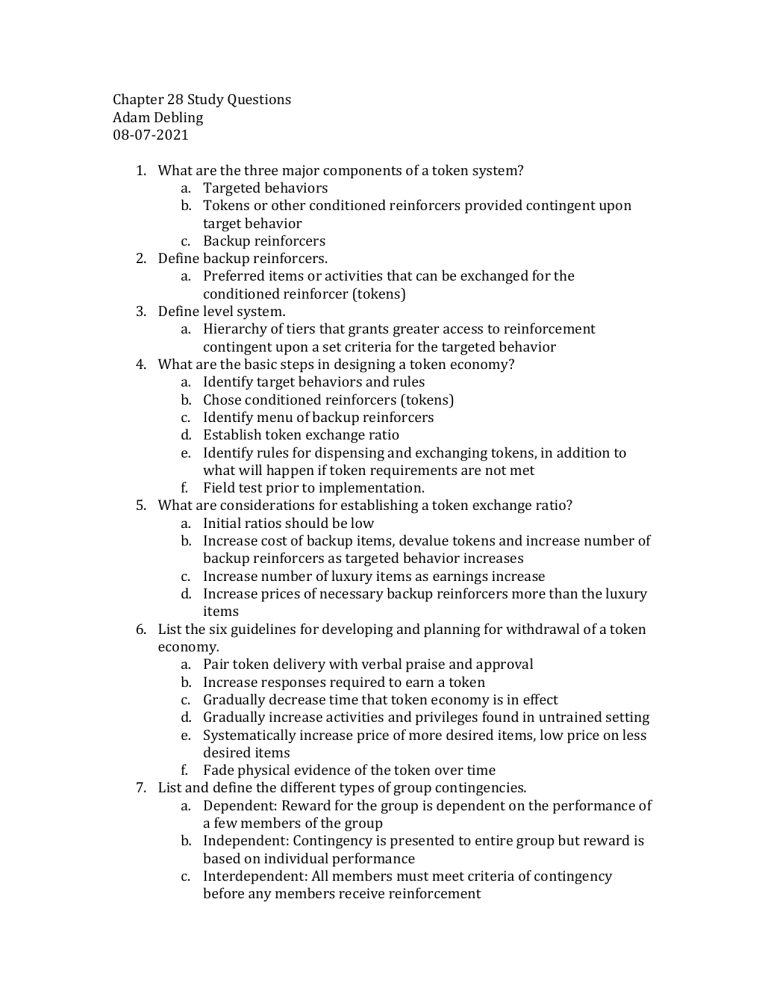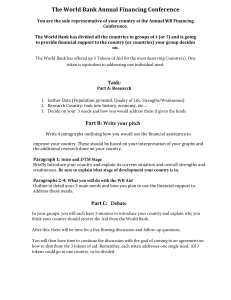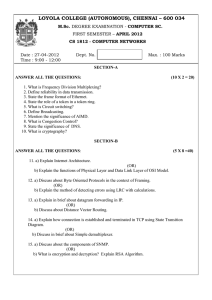Behavior Analysis Study Questions: Token Systems & Self-Management
advertisement

Chapter 28 Study Questions Adam Debling 08-07-2021 1. What are the three major components of a token system? a. Targeted behaviors b. Tokens or other conditioned reinforcers provided contingent upon target behavior c. Backup reinforcers 2. Define backup reinforcers. a. Preferred items or activities that can be exchanged for the conditioned reinforcer (tokens) 3. Define level system. a. Hierarchy of tiers that grants greater access to reinforcement contingent upon a set criteria for the targeted behavior 4. What are the basic steps in designing a token economy? a. Identify target behaviors and rules b. Chose conditioned reinforcers (tokens) c. Identify menu of backup reinforcers d. Establish token exchange ratio e. Identify rules for dispensing and exchanging tokens, in addition to what will happen if token requirements are not met f. Field test prior to implementation. 5. What are considerations for establishing a token exchange ratio? a. Initial ratios should be low b. Increase cost of backup items, devalue tokens and increase number of backup reinforcers as targeted behavior increases c. Increase number of luxury items as earnings increase d. Increase prices of necessary backup reinforcers more than the luxury items 6. List the six guidelines for developing and planning for withdrawal of a token economy. a. Pair token delivery with verbal praise and approval b. Increase responses required to earn a token c. Gradually decrease time that token economy is in effect d. Gradually increase activities and privileges found in untrained setting e. Systematically increase price of more desired items, low price on less desired items f. Fade physical evidence of the token over time 7. List and define the different types of group contingencies. a. Dependent: Reward for the group is dependent on the performance of a few members of the group b. Independent: Contingency is presented to entire group but reward is based on individual performance c. Interdependent: All members must meet criteria of contingency before any members receive reinforcement 8. List and explain the six guidelines for implementing group contingencies. a. Choose an effective reward b. Determine targeted behavior, any collateral behaviors c. Set appropriate criteria d. Use combination of procedures if necessary e. Select most appropriate group contingency f. Monitor performance of both group and individual 9. Define contingency contract. a. Document that defines a contingent relationship between a targeted behavior and a specified reward. 10. What are the steps for developing a contingency contract? a. Task: Who will perform, what is the behavior, when must the behavior occur, how well the task must be completed b. Reward: Who will judge task completion, what is the reward, when specifies the time the reward is available c. Task record: Recording task completion and reward delivery Chapter 29 Study Questions 1. Explain Skinner’s two-response conceptualization of self control. a. The controlling response affects the variable which change the probability of the controlled response. 2. Define self-management. a. Behavior emitted by someone to influence another behavior 3. What reasons does your text give for recommending the use of selfmanagement in reference to a person acting “in some way in order to change subsequent behavior”? a. Self-control is inherently misleading, implies control of behavior lies within the person b. Attributing behavior cause to self-control can serve an explanatory purpose c. Both laypeople and behavior analysts refer to self-control as one’s ability to delay gratification 4. Define delay discounting and give an example. a. The greater the delay to a reward the less reinforcing it is to a behavior. b. Example: A cookie provide 5 minutes after a targeted behavior occurred will most likely not reinforce that behavior. 5. Explain the four basic applications of self-management. a. Living more effective and efficient life b. Breaking bad habits and gaining beneficial ones c. Accomplishing difficult tasks d. Achieving personal goals 6. List at least three tactics for antecedent-based self-management. a. Manipulate MOs b. Provide response prompts c. Perform initial behavior chain steps 7. Define self-monitoring. a. Self-observation and recording of one’s occurrence or nonoccurrence of behavior. 8. Why is it difficult to determine exactly how self-monitoring works? a. What behavioral principles are operating when self-monitoring changes the target behavior is unknown because the self-monitoring procedure consists of private events or thoughts 9. What are suggested guidelines for self-monitoring? a. Provides materials that make self-monitoring easy b. Provides supplementary cues and cards c. Self-monitor most important dimension of target behavior d. Self-monitor early and often e. Reinforce accurate self-monitoring 10. What are suggestions for implementing self-administered consequences as part of a self-management program? a. Select small and easy to deliver consequences b. Set meaningful but not too easy criteria c. Eliminate bootleg reinforcement d. Use another individual to deliver consequences if necessary e. Keep it simple 11. Explain habit reversal. a. Clients are taught to self-monitor by identifying and interrupting behavior changes by engaging in incompatible behavior 12. List the six steps for designing and implementing a self-management program. a. Specify a goal and define behavior b. Self-monitor the behavior c. Create contingencies that will compete with natural contingencies d. Go public with commitment to change behavior e. Get a self-management partner f. Continually evaluate your self-management program and redesign it as necessary.




